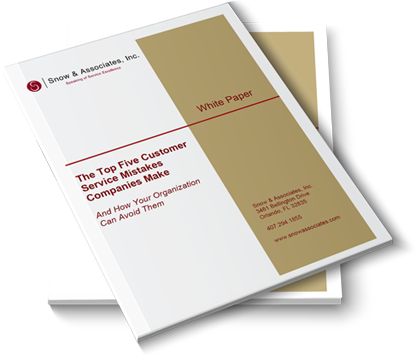
The Top Five Customer Service Mistakes That Companies Make
And How Your Organization Can Avoid Them.
Posted on October 22, 2009 by Dennis Snow
An article appeared in Tuesday's Wall Street Journal titled, "Firms Keep Brakes on Hiring: Unsure About Strength of Upturn, Employers Produce More With Fewer Workers." The article notes that while hiring always lags behind economic recoveries, this time the lag is likely to be worse. Doubts about the strength of the recovery and concerns about the potential costs of health care reform are two of the reasons the WSJ says companies may be slower to replenish their employment ranks.
One sentence in particular jumped out at me as I read the article: "Employers shed workers faster than they cut output." In effect, output per hour grew as actual hours worked dropped - our employees are truly doing more with less. A lot more. Workplace efficiencies and productivity increases are good, of course. But sometimes the increases are achieved at the expense of good management practices, resulting in employee burnout.
Burned out employees aren't likely to deliver a stellar experience to our customers. Yes, we've all had to do more, work harder, and just get things done when times are tough, and I'm not saying that shouldn't be the case. What I am saying is that during lean times leaders have to be extra aware of employee morale and its impact on the customer experience. I don't think most employees mind working harder if, a) they see a light at the end of the "more with less" tunnel, and b) they feel appreciated for what they're doing.
As leaders, we can't guarantee an end to the "more with less" issue, but we can certainly do something about the appreciation issue. Here are four strategies that I recommend leaders consider in order to deal with the employee burnout factor:
1. Celebrate and appreciate more than ever before - Mini celebrations for getting a difficult order out on time, surviving a busy season while understaffed, maintaining quality standards, or "just because" can go a long way in letting employees know that you know how hard they're working. Acknowledging strong individual performance as soon as you know about it at least indicates you're noticing the situation and appreciate the extra effort. One-on-one time with employees is more important now than any time in the recent past.
Do your employees feel appreciated?
2. Provide specific training that helps employees improve productivity - Saying to employees, "We're all just going to have to suck it up and do more with less," is not uncommon and not even unreasonable in lean times. But it's something altogether different if we say the same thing, but provide education on how to deal with the workload increase. Training on time management, dealing with difficult customers, effectively using the capabilities of current technology, stress management, etc. are all options that, while not making the increased workload go away, help employees to deal with it. And it says that management knows the challenges employees are facing.
What training can you provide to help employees deal with the increased workload?
3. Provide new tools or adapt old ones to set employees up for success - A simple revamp of the work schedule, for example, is sometimes all it takes to make sure that you have optimum coverage at crunch times. While work schedule changes can cause employee frustration, I find that most employees are even more frustrated when staffing levels don't align with actual workload fluctuations.
One call center recognized that, due to staffing reductions, customer hold times were likely to increase, and that the remaining employees would bear the brunt of the customers' dissatisfaction. So, they changed the hold message from one that repeatedly pushed the company's products to one that provided famous comedy routines from the past. Yes, hold times increased, but the increase was softened by the new message.
What tools can you provide to set your employees up for success?
4. Take extra care in hiring - This may sound strange when up to this point I've been talking about companies not hiring. The reality, however, is that many companies are hiring, just not nearly to the degree as in the past, and not enough to meaningfully ease the workload. So, the hiring decisions you make now may be some of the most important you'll ever make. These hires will need to contribute faster than ever before and will be under the microscope of every fellow employee. A bad hire now will hurt morale more than ever because your current employees don't just want help, they more than likely need help.
If you've never involved your employees in the hiring process, now may be the time to do it. They have a vested interest in a successful hire, and know what it takes to make a contribution to the team. While I believe peer interviewing is always a good idea, now it's a great idea.
Are you involving your employees in the hiring process?
I've heard and read many comments about how employees today need to appreciate the fact that they have jobs at all and, in fact, most employees are appreciative. As the economy turns around, however, employees will begin to have choices again. The employment pendulum's swing sometimes favors companies and sometimes it favors workers. As the pendulum begins to swing back, at least towards the middle ground, how companies have treated their employees during these tough times will be remembered. What memories will your employees have?